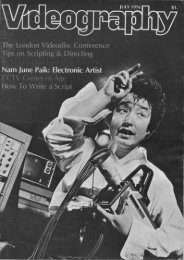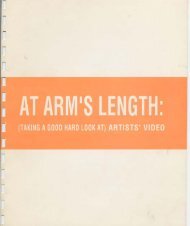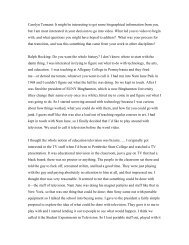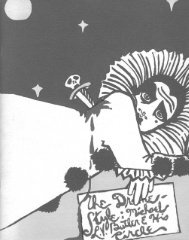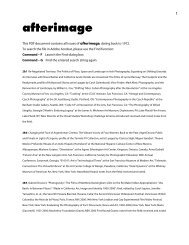The Language of Video - Experimental Television Center
The Language of Video - Experimental Television Center
The Language of Video - Experimental Television Center
You also want an ePaper? Increase the reach of your titles
YUMPU automatically turns print PDFs into web optimized ePapers that Google loves.
<strong>Video</strong>, as the youngest development in the visual medium, is still in the process<br />
<strong>of</strong> defining its grammatical structures to form its own language. Rooted in cinematic<br />
tradition, one <strong>of</strong> a photographic, representational, narrative, mimetic approach, the<br />
particulars within the development <strong>of</strong> video technologies were a striving to achieve a<br />
more “malleable” 1 handling, capable <strong>of</strong> being both captured and transmitted in one<br />
simultaneous action.<br />
<strong>Video</strong>, once intended for the purposes <strong>of</strong> broadcasting <strong>of</strong> mass media networks , finds<br />
itself at an age <strong>of</strong> accessibility to the public in a set <strong>of</strong> inexpensive and culturally<br />
incorporated tools. It has moved away from its original purpose and has landed at a point<br />
where it is finally an accessible medium for the arts.<br />
Taking into consideration technology as means, as a tool for creative expression,<br />
and not as an end in itself, it is necessary to introduce to the viewing public (now more<br />
than ever, now that video has become so commodified), that the moving image has<br />
evolved to a state where this quality <strong>of</strong> “malleability,” together with the increasing<br />
technological developments <strong>of</strong> computerized real time processing, gives the medium<br />
characteristics similar to those <strong>of</strong> paint for the painter, clay for the sculptor, words for a<br />
poet, or sound for the musician. In essence, it has the potential to become the<br />
contemporary medium for a visual, creative, artistic expression.<br />
As metaphors are to the written word, poetic representations and beautifications<br />
inspired in our surroundings, the elements in video composition begin to take the form <strong>of</strong><br />
an individually inspired process <strong>of</strong> reading/seeing in between the lines/frames.<br />
<strong>The</strong> spectator, thus, acquires an essential role in the observance <strong>of</strong> the message—<br />
role that has been hindered by the overpoweringly controlled messages <strong>of</strong> mass media.<br />
<strong>The</strong> spectator becomes an active agent, where both their individual sensation <strong>of</strong> the visual<br />
1 <strong>Video</strong> is an immediate form. In the sense that the distances between the recording and<br />
the final product have been bridged. What you see in the viewfinder <strong>of</strong> a video camera is<br />
what is being recorded, as opposed to film and analog photography, where the final<br />
product <strong>of</strong> the recording is a process <strong>of</strong> chemical reactions that occurs after the fact <strong>of</strong><br />
seeing.
stimulus and the process <strong>of</strong> concept-formation (what has been called “perception”) are<br />
the synthesizing factors <strong>of</strong> the reception <strong>of</strong> the final message.<br />
Art is a communicative process. A bi-directional set <strong>of</strong> interchanges between the<br />
artist (voiced through their work) and the spectator. In a work where the spectator<br />
receives representational and recognizable images, the interchange is dulled by the<br />
transmittance <strong>of</strong> messages that are driven to specific and mapped out concept formations<br />
and reactions.<br />
A work that is composed <strong>of</strong> non-recognizable elements, on the other hand, becomes an<br />
exercise in contemplation for the observer, where the formation <strong>of</strong> concepts is a<br />
derivative <strong>of</strong> a series <strong>of</strong> interpretive events. <strong>The</strong> spectator’s role is active in that the<br />
message is constructed by intuitive and individually formed reactions to a perceptive<br />
experience.<br />
<strong>The</strong> “malleability” <strong>of</strong> the video medium allows for all possible gradations<br />
between the representational, the concrete, and the abstract, or the imaginary. Balanced<br />
carefully, the results convey messages that are a product <strong>of</strong> both the transmission <strong>of</strong> a<br />
particular message and the result <strong>of</strong> an interpretive process <strong>of</strong> the viewer, who, engaged<br />
in contemplation and deep observation, is able to come away from the work with<br />
reminiscent images <strong>of</strong> new patterns and shapes present in our everyday surroundings.<br />
<strong>The</strong> perceptive process is like a muscle, and can be expanded by “educating the<br />
eye” into finding the magical and imaginary in everyday things. <strong>Video</strong> has all the<br />
attributes necessary (color, form, time or rhythm, and space) to be yet another vehicle for<br />
the expression <strong>of</strong> the inexpressible, <strong>of</strong> the imaginary, <strong>of</strong> the unreal.<br />
Bibliography:<br />
Wassily Kandinsky “Concerning the Spiritual in Art.”<br />
Piet Mondrian “<strong>The</strong> New Art –<strong>The</strong> New Life.”<br />
Rudolph Arnheim “Art and the Visual Perception.”<br />
Frank Popper “Origins and development <strong>of</strong> Kinetic Art.”<br />
John Whitney “Digital Harmony, on the Complimentarity <strong>of</strong> Music and Visual Art.”





